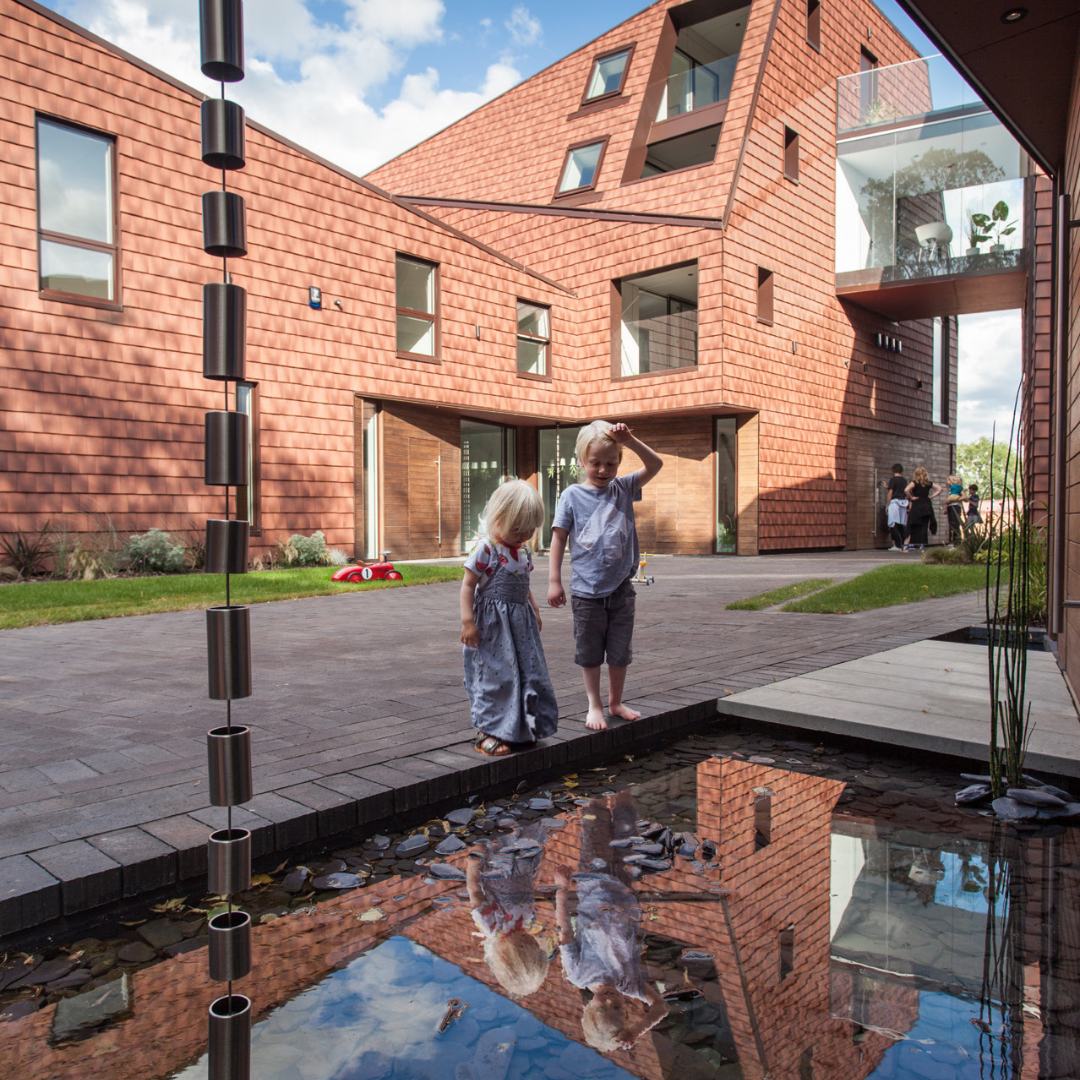Project showcase
Kaolin Court, Lewisham - House of Tuesday, with Stolon Studio

Kaolin Court is a small ‘sociable’ housing development set around a shared garden. Balancing privacy with a space that encourages interaction, this place offers a scaleable solution to liveable housing at urban density.
Where is the project located?
Kaolin Court, 33-39 Beadnell Road, London SE23 1AA
Who is the developer/client of the project?
House of Tuesday
Who is on the project team? Stolon Studio (Architect, landscape, interiors), Edge Structures (Engineer), Prospero Projects (M&E Consultant), Pulse Consulting (Cost Consultant), Turner Timber Frame, Meridian Construction (Main Contractor)
Describe the context of this project, its neighbourhood and people?
Kaolin Court is located on a residential street, predominantly comprising 3-storey Victorian houses with the train line to the north and a local industrial zone to the south. Opposite the development, the 1-2 storey industrial units face inward to each other and are set below the pavement level, creating a distinctly different environment. As such, there is an interesting mix of older pattern book houses, vernacular infill development and utilitarian industrial buildings.
The wider neighbourhood of Forest Hill is a sub-urban settlement, within LB of Lewisham. It was established during the big outward growth of London, where people sought to find a new home away from the big ‘smoke’ and with a slice of countryside in their small private garden. In 2010, the Overground connection linked Forest Hill to London Underground network, and a resurgence in the popularity of the suburb followed.
Around 35% of local households are families with children, and the predominant age group of adults is 30 – 44. As is common in London, many families do not have extended family close by. There is an active local community with many creative businesses also based in the area.
Prior to the development of Kaolin Court, the street was a bit of a hotspot for anti-social behaviour as the 2 industrial plots on the largely residential street created a ‘dark spot’ in the night-time activity along the road. On a small scale, this illustrates the importance of night-time activity, something that would be resolved through the new development.
What makes this place thrive? How does the community come together? What makes this a great place to live, work, play, visit or learn?
Kaolin Court is a small ‘sociable’ development set around a shared garden. Popularised locally by Forest Mews, the concept of sociable housing was already proving a desirable alternative. Key is creating a space that encourages interaction, balanced with privacy. Private and public thresholds are carefully mediated, allowing residents to engage in communal activities such as dining, studying, relaxing, and playing together, but able to retreat to their own space.
According to a resident, “through sharing, we have more”. Average gardens in Lewisham measure up at 72 sqm (London Wildlife Trust). The shared space is over 200 sqm. But size isn’t everything. More sociably valuable space increases the chances of forming connections.
The outcome: there is always someone to help, to talk with, to listen, to play with. During COVID lockdowns, this type of interaction has become increasingly more valued. The clear benefits of living in this way have been documented through the resident accounts and interviews:
‘Outside the walls of the community there is uncertainty and anxiety. Yet … we find respite inside … Never have I felt more connected to the environment and community we live in. The space allows for all of us to sit at our respective tables outside and do a nearly daily aperitivo hour. The kids, who do not understand social distancing, get the nourishment from each other essential to their development … (I) hope this model of living is an inspiration for future housing developments where community is deemed an essential, not an outcome.’
How has this place adapted, and how does it continue to adapt, to changing demographics, behaviours, market context, policy, transport habits and the climate crisis? What makes it resilient?
COVID expanded activities in the home, bringing more: workspaces, schools, gyms, restaurants, dancefloors as well as places for rest, refuge and refuel.
Built pre-COVID, homes at Kaolin Court were work ready - pre-wired with fibre and ethernet points throughout. They had/have flexible open plan spaces that residents easily adapted for a host of activities, which continue. However, the greatest drawback of home working is isolation. Even before COVID, 1 in 5 homeworkers cite the struggle with loneliness and isolation.
The emphasis on sociable spaces for interaction and well-designed, uplifting, naturally-lit spaces with easy access to nature, provided the basis for supporting the resident’s well-being.
The large ‘picture’ windows overlooking the courtyard and set against a shallow reflecting pool – proved to be a popular spot for homeworking, while other residents chose a 1st floor bedroom also overlooking the courtyard.
The shared courtyard became multi-functional: home schooling, break, impromptu alfresco dining and end of the day relaxation. Most housing in London is planned in rows or blocks, with little opportunity for community, particularly directly alongside homes. Planning policy focuses on individual unit sizes, but largely overlooks options that enable alternative arrangements.
A place where people “break bread together” builds a resilient community. Globally, people face more uncertainty surrounding energy, fragmenting opinion, mental health, and climate change – communities working together makes these tasks less insurmountable. Empathy and breaking down barriers between groups helps to support action. Concepts at Kaolin Court can be transferred, but also enlarged to create more resilient communities.
Please share any data or evidence about the social, economic and environmental performance of this place? Article references or quotes from supporters or reviews in the media may also be included.
The brief was to create a development that appeals to families and professionals and integrates sustainable design within the building fabric. Whilst it is a sculptural building, the forms are driven by function, created using solar and daylight modelling; and further consideration given to natural ventilation, passive cooling, overheating, internal daylight levels, flood-risk, home-working, community and ecology. Timber frame with vaulted ceilings and ground floor thermal mass create warmth in the winter and cool in the summer. A high-performance building envelope was designed, using low u-values, triple-glazing, good solar orientation, and low air-permeability.
The development/building was designed around the sun. The roof forms allow sunlight into the shared courtyard and ground floor of units. The terraces to the flats are located on the western façade, also overlooking the courtyard. The ridgeline was rotated to create south facing roof planes, for solar panels, and in turn to reduce overshading to the amenity space. A fabric first approach was able to meet regulations, without renewables, nor compromising the visual integrity. As the development is not reliant on renewables to pass regulations, it can further reduce CO2 by use of renewables, green energy suppliers or retrofitting heat pumps. The underfloor heating, oversized radiators and bin/bike stores with ventilated doors have been specified to allow airsource heat pumps to be retrofitted in the future.
The building exceeds the RIBA 2030 climate challenge targets. The development met the 2020 target of <105 kWh/m2/yr and 1/3 of the development met the 2025 targets <70 kWh/m2/yr.
Festival of Pineapples
24-26 February 2026
Pineapples prize giving night
April
Pineapples at Festival of Place
10 June 2026
© The Pineapples - Tweak Ltd. 124 City Road, London, EC1V 2NX. Tel: 020 3326 7238




